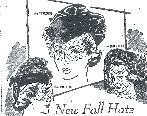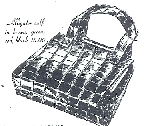Fashions and Accessories Men's, ladies and childrens fashions in the 1940's
Pre-War and Post-War 1940s Fashion Trends
A shift in dress happened from during WWII to after the war ended. The styles of this time signified the darkness of this particular time in history.One of the most significant examples of wartime fashion are the uniforms worn by military members and their brides. The groom would usually wear his service uniform and the bride would wear something that today’s time would consider a simple office skirt suit.
Fashion Attitudes During Wartime
Before the war, frivolous and glamorous style was out. Additionally, clothing rations limited the types of materials available for making and/or obtaining clothes.For instance, there was only a limited supply of wool during this time, starting in 1942. Instead, artificial fibers such as viscose and rayon were used. These materials were derived from wood pulp.
The colors of clothing during this time were of plain and solemn colors. Most outfits were of a solid color such as ivory (for women’s wedding suits), black, navy, or other dark colors.
Ladies fur coats were available and included Ladies Fur Coats they were made from Coney ( Rabbit ) and dyed to look like Mink, Sable, Seal or Beaver
Quite a bit of mending was happening during the war to make clothes last as long as they could. Additionally, the British government had made it unlawful to participate in the practice of using excess buttons, decorative trimmings, and extra stitching (i.e. what would be used for folds, pleats, gathers, etc.) on clothing
Most of the jewelry available in World War II was Costume Jewelry example of ladies costume jewelry from 1945
Practicality was of great essence during this time. Clothing was meant just to cover the body, and it was designed for the busy men and women involved in fighting or working during this time.
Perhaps one could liken World War II fashion to that of a perpetual funeral. Even wedding clothing was quite drab during this decade. The only difference was that women’s wedding suits were usually white or ivory-colored.
Influence of Wartime London Fashion Designers
In the year 1942, a group known as the Incorporated Society of Fashion Designers created over 30 different new utility clothing designs. This particular group most likely was the one that made the most out of the simplistic clothing style trend of this time.For the women, the suits that this company made were not as broad-shoulders as others (but were still squared). The jackets and skirts of these suits were more contoured to the shape of a woman’s body, and looked more feminine than other box-cut patterned women’s suits of the time.
The London clothing fashion design group made the most of the wartime limitations. For instance, they learned how to make a woman’s suit blazer (suit jacket) look eloquent event with three buttons. These suits were more affordable by those who were more affluent.
A very popular suit that women wore during the war was named the “siren suit”, after the act of civilians hiding in an air raid shelter to protect themselves. These suits were made from a tartan cloth.
Ladies Coney Fur Coat

Australian Seal Dyed Coney Fur
Price: $79.00
Ladies 2 Piece Suit

Black 2 piece Suit
Price: $22.95
Ladies Fashion Hats

New Fall fashion hats
Price: $2.49
World War II Accessories
Women during World War II typically wore head scarves, turbans, wedged-heal shoes (versus high heels), and the kangaroo cloak. Safety for women while working in the factory was just as important as style during this time.The kangaroo cloak was a very signature piece of wartime clothing/accessory. It had huge pockets for stuffing household items into while running for shelter after the siren would go off.
The shoes that women wore during these times contained cork. This was largely in part as a result of the shortage of leather. Clogs were worn quite a bit during these times as well. Both of these types of shoes were very comfortable to walk in, especially the cork-soled ones.
Hand knitted winter gloves and scarves were also very popular during these times. Additionally, the “Make Do and Mend” motto of these times included created shorts out of sheets (or pillow cases), coats out of warm blankets, and wedding dresses out of nightgowns.
Industrial cloth, parachute silk, and parachute nylon were some of the household materials that clothing was made of. Furthermore, handbags were made from milk tops. Ankle socks were worn more often than pantyhose, which were rare.
Wartime Men’s Clothing Fashions
Men wore suits for special occasions made from rationed materials as well-sometimes until they had been worn out. They sometimes wore V-necked sweater vests or knitted waist coats for these occasions as well, over a shirt and tie (under a suit jacket).The military outfits of this time were very simply made, however. They did not come with pocket flaps or vests, and the trousers were neither made with pleats nor cuffs.
An illicit item during the war was called the “zoot suit”. This was an item that was usually worn in night clubs. It consisted of an oversized jacket, wide lapels, broad shoulders, and low crotches. The pant legs of these suits narrowed towards the ankles.
Post War Fashions: 1947-1949
People anxiously awaited the day when newer types of clothing would be allowed to be distributed. It took quite some time before the U.S. was able to access the same kinds of fashions that were made available in Paris, France or London, England.American created its own new look during this time. One of the major influences of U.S. fashion after the war was Clair Mc Cardell. One of her signature pieces is a cotton dress that is grey with brown and red stripes, and each of the narrow stripes has tiny hearts imprinted in them.
This Clair Mc Cardell dress has a V-necked bodice. Moreover, the sleeves are flared and the skirt is of and eight-gore style with soft folds. The most memorable attribute of this historical dress is the way the stripes on either side of the dress meet and create a “W” shape around the waist as well as the bodice.
A large amount of casual evening and sports wear was made after the war as well. This was fitting for people of an active lifestyle.
Men’s fashion in the U.S. after the war had changed as well. One of the most dramatic new additions to male fashion introduced after 1947 was the Hawaiian and Carisa shirts. These were first worn on California and Florida beaches, and were made with fabric imprinted with patterns of ocean flora, women, island flowers, or flames.
In the last year of the 1940s decade another new fashion item had emerged. The Esquire jacket had came out. It had broad shoulders and was very loose-fitting. Double-breasted suit jackets designed with center vents and peaked lapels also became more popular after the war.
Sportswear also became the American clothing icon after World War II was over. In fact, Europe turned to the U.S. after awhile for new ideas pertaining to sports fashion.
Ladies Shoes

Ladies leather Shoes
Price: From $6.95 to $9.95
Alligator bag

Ladies Alligator bag in Red , Green and Black
Price: $15.95
Some examples of Fashion Prices in the 1940's taken from newspaper Adds
Simulated Leather Handbags $2.98 California 1944Men's raincoats $7.99 South Carolina 1949
Men's Sweat Shirt $1.14 South Carolina
Men's Gaberdine Slacks $4.95 Ohio 1945
Nylon Hose $1.65 New York 1947
Ladies Sandal $6.95 New York 1948
Girls Blouses $2.95 Wisconsin 1948
Ladies Bra From $1.25 Wisconsin 1948
Ladies Gloves $1.99 Wisconsin 1948
Ladies Manicure $1.00 California 1945
Men's heavy duty Work Shoes $3.95 Wisconsin 1946
Men's and Ladies House Slippers 95 cents Wisconsin 1946
Cap & mitten sets, $1.48 New Jersey 1946
Men's shirt, $3.70 New Jersey 1946
Men's slippers, $1.98 New Jersey 1946
Women's skirt, wool $5.40 New Jersey 1946
Woman's suit, wool $21.00 New Jersey 1946